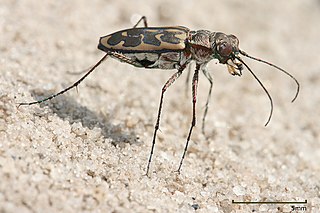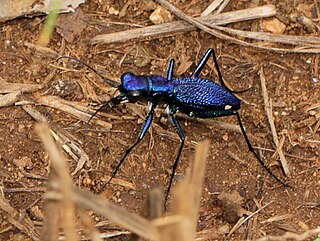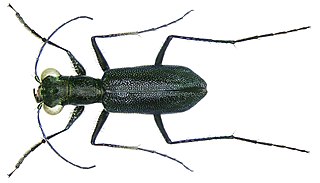
Big Horn County is a county in the U.S. state of Wyoming. As of the 2020 United States Census, the population was 11,521. The county seat is Basin. Its north boundary abuts the south boundary of Montana.

Tiger beetles are a family of beetles, Cicindelidae, known for their aggressive predatory habits and running speed. The fastest known species of tiger beetle, Rivacindela hudsoni, can run at a speed of 9 km/h, or about 125 body lengths per second. As of 2005, about 2,600 species and subspecies were known, with the richest diversity in the Oriental (Indo-Malayan) region, followed by the Neotropics. While historically treated as a subfamily of ground beetles (Carabidae) under the name Cicindelinae, several studies since 2020 indicated that they should be treated as a family, the Cicindelidae, which are a sister group to Carabidae within the Adephaga.
The Johns Hopkins School of Education is the school of education of Johns Hopkins University, a private research university in Baltimore, Maryland, United States. Established as a separate school in 2007, its origins can be traced back to the 1909 Founding of Johns Hopkins's College Courses for Teachers, later renamed College for Teachers.

A horn is a sound-making device installed on motor vehicles, trains, boats, and other types of vehicles. The sound it makes usually resembles a “honk” or a “beep”. The driver uses the horn to warn others of the vehicle's presence or approach, or to call attention to some hazard. Motor vehicles, ships and trains are required by law in some countries to have horns. Trams, trollies, streetcars, and even bicycles are also legally required to have an audible warning device in many areas.

Dromica is a genus in the beetle family Cicindelidae. There are at least 190 described species in Dromica, found in Africa.

Megacephala is a small genus of beetles in the family Cicindelidae restricted to Africa; it was formerly a much larger genus, but its constituent species have been subsequently placed in other genera, primarily Tetracha, but also Grammognatha, Metriocheila, Phaeoxantha, and Pseudotetracha.

Neocollyris is a genus of tiger beetles in the family Cicindelidae and tribe Collyridini, found in southern and South-East Asia.

Prothyma is a genus in the beetle family Cicindelidae. There are more than 40 described species in Prothyma.

Phaeoxantha bifasciata is a species of tiger beetle in the subfamily Cicindelinae that was described by Brullé in 1837, though for most of the past 200 years it has erroneously been recognized under the name aequinoctialis, a name based on a misidentified bombardier beetle. The species is found in South American countries like Argentina, Bolivia, Brazil, Colombia, Ecuador, French Guiana, Peru, and Venezuela.
Phaeoxantha bucephala is a species of tiger beetle in the subfamily Cicindelinae, described by W. Horn in 1909.

Phaeoxantha cruciata is a species of tiger beetle in the subfamily Cicindelinae that was described by Brulle in 1837. The species is common in Argentina, Bolivia, Brazil, Paraguay, and Uruguay.
Phaeoxantha epipleuralis is a species of tiger beetle in the subfamily Cicindelinae that was described by George Henry Horn in 1923. The species has been recorded in South America, particularly in Brazil.
Phaeoxantha laminata is a species of tiger beetle in the subfamily Cicindelinae that was described by Perty in 1830, and can be found in Argentina, Brazil, Paraguay, and Peru. Its species name has frequently been misspelled as limata.
Phaeoxantha lindemannae is a species of tiger beetle in the subfamily Cicindelinae that was described by Mandl in 1964.
Phaeoxantha wimmeri is a brown coloured species of tiger beetle in the subfamily Cicindelinae that was described by Mandl in 1958, and is endemic to Santa Cruz, Bolivia.
The Mended Lute is a 1909 American short silent Western film directed by D. W. Griffith and starring Florence Lawrence. It was produced by the American Mutoscope and Biograph Company.

Events from the year 1745 in Sweden
Phaeoxantha is a genus of tiger beetles in the family Cicindelidae, formerly included within the genus Megacephala.
Phaeoxantha testudinea is a species of tiger beetle in the subfamily Cicindelinae that was described by Klug in 1834.
Phaeoxantha nocturna is a species of tiger beetle in the subfamily Cicindelinae that was described by Dejean in 1831.









